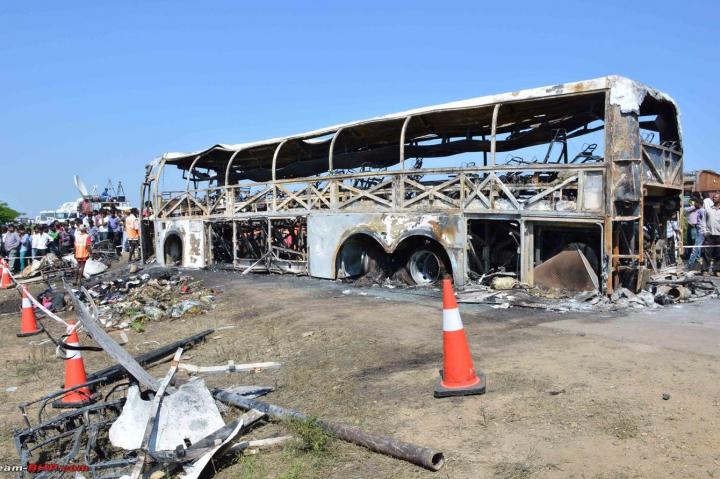News
Instigated by the recent fires/crashes: 7 ways to make bus travel safer
Passenger safety on public & private buses definitely needs an upgrade in terms of safety features.
BHPian anjan_c2007 recently shared this with other enthusiasts.
In the aftermath of this new generation of AC sleeper and also non-sleeper buses turning into mobile infernos and coffins, the Ministry of Road Transport and Highways needs to sit up, act and take a second look at the extant safety features that are offered on these along with the serious gaps and shortcomings. We have seen the loss of defenceless and innocent lives, who have been charred to death within a few minutes of the fire engulfing these buses. We have had the Nagpur- Pune bus charring 25 passengers to death on the intervening 30 June- 1 July 2023 night. A thread is here, discussing the accident.
A look at these recent fire incidents is spine-chilling:
- June 2022, seven passengers were charred to death when the Goa-Hyderabad bus collided with a goods carrier
- August 2020, five passengers were burnt alive due to a fire in a private company bus at Chitradurga dist. The bus was going from Vijayapura to Bangalore and the fire was reportedly due to a malfunction of the bus' engine
- April 2014, At least six passengers were burnt to death and a dozen injured early Wednesday when the private-run bus in which they were travelling caught fire in Karnataka, an official said. The tragedy occurred around 3 a.m. when the bus from Davangere to Bangalore caught fire and fell into a ditch on the side of national highway four (NH 4)
- October 2013, forty-five passengers were charred to death as a private Volvo bus burst into flames after its fuel tank caught fire in the Mahbubnagar district of Andhra Pradesh early on Wednesday. The accident occurred at 5.10 am when the diesel tank of the Hyderabad-bound bus from Bangalore hit a culvert near Palem in Mahabubnagar, around 140 kms from Hyderabad on NH-44 (Bangalore-Hyderabad), police said, adding the entire bus was engulfed in flames in a matter of minutes.
Most of these accidents occurred during the night or the wee hours of the day when passengers were asleep.
Some safety measures are suggested herein that need to be legislated and made mandatory to minimise such loss of lives, as the situation becomes more and more scary for all bus users and their near and dear ones.
- Heavy-Duty Torsion Bars: To prevent full dislodging of the front/ rear axle, this calls for fitment of heavy-duty torsion bars on both the front and rear axles of buses to deter total detachment of the rigid, live/dead axles, that these commercial vehicles are fitted with. Rigid live/ dead axles have torsion bars normally, but heavy-duty ones can prevent total dislodging of the axle. Such mandatory fitments of heavy-duty torsion bars on rigid live/dead axles can be life savers. Most cars these days come with independent front and rear suspensions, but most heavy-duty transport vehicles have the age-old rigid live/dead front and rear axles. The Nagpur- Pune bus' front axle was dislodged after it hit a median and the bus went out of control instantly.
- Diesel Tank Relocation: The diesel tank needs relocation to a better and more secure spot within the longitudinal members of the ladder frame chassis and not on either edge (present location) as these have in umpteen cases hit medians and triggered fires.
- Emergency Exits Redesigning and Glass Breaking Hammers: The main entry-exit door is to the left and the bus toppling and resting to its left, with the main door and the right side emergency exit inoperative, these leave many gaps that are deterrents to the safety norms. There should be at least two or more glass-breaking hammers, on different locations within each AC bus that are prominently displayed. The driver’s side door and emergency exit need to be of reasonable dimensions to enable even frail and aged passengers to egress during emergencies. The driver’s seat needs to fold to allow egress. The seats/ berths around the emergency exit need to be allotted to fit and agile passengers and facilitate seamless egress. Such seats and berths need to fold to facilitate exits. A safer emergency exit door on the backside of buses needs to be made mandatory to enable exits when the bus topples either to its left or right, that prevent other exits/ doors from opening.
- Window Curtains of Cotton Only: The curtains for all such buses need to be compulsorily of cotton fabric. Usually, these are thick and made of fire-prone, synthetic materials that act as catalysts to aggravate the fire. And being located near windows these are a deterrent to safely exit the bus either from the emergency exits or after breaking open the window glass.
- Whether Rear Engine Location is Safe in our Conditions: The engine location to the rear in many new generation buses could also be another factor triggering fires. Its relocation needs to be debated.
- Demonstrations of Emergency Provisions: The bus crew needs to demonstrate emergency provisions to all passengers fitted on the bus in person or through videos, to educate passengers about the safety measures available within. This needs to be done at the embarking point/s mandatorily.
- Drivers and Cleaners are Captains: The driver and cleaner are supposed to be captains of the bus who need to guide passengers to safety in case of emergencies for which they themselves need to be trained. Such training can best be imparted by the National Disaster Response Force (NDRF) which should be made mandatory for all such bus drivers and cleaners as a qualification.
These measures need to come into the statute books as rules and laws. After all, the AC cabins for truck drivers and also the six airbags per car, musical horns playing Indian instruments and all such proposed measures as pronounced by the MoRTH can be relegated to the back seat and bus passenger's safety needs to be prioritised as these involve many human lives.
Each bus carries tens of passengers and their lives need to be treated as precious by the government to take safety measures on a priority basis.
Check out BHPian comments for more insights and information.
- Tags:
- Indian
- Member Content
- Accident
- Bus


















